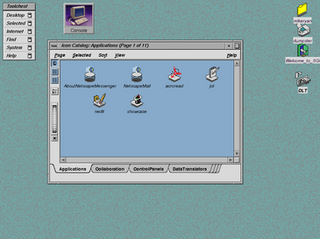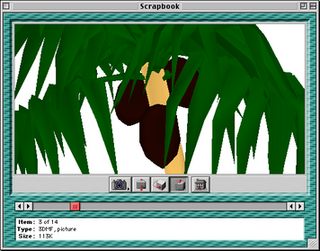
IRIX is a discontinued operating system developed by Silicon Graphics (SGI) to run on the company's proprietary MIPS workstations and servers. It is based on UNIX System V with BSD extensions. In IRIX, SGI originated the XFS file system and the industry-standard OpenGL graphics API.

OpenGL is a cross-language, cross-platform application programming interface (API) for rendering 2D and 3D vector graphics. The API is typically used to interact with a graphics processing unit (GPU), to achieve hardware-accelerated rendering.

VRML is a standard file format for representing 3-dimensional (3D) interactive vector graphics, designed particularly with the World Wide Web in mind. It has been superseded by X3D.

A scene graph is a general data structure commonly used by vector-based graphics editing applications and modern computer games, which arranges the logical and often spatial representation of a graphical scene. It is a collection of nodes in a graph or tree structure. A tree node may have many children but only a single parent, with the effect of a parent applied to all its child nodes; an operation performed on a group automatically propagates its effect to all of its members. In many programs, associating a geometrical transformation matrix at each group level and concatenating such matrices together is an efficient and natural way to process such operations. A common feature, for instance, is the ability to group related shapes and objects into a compound object that can then be manipulated as easily as a single object.
Fahrenheit was an effort to create a unified high-level API for 3D computer graphics to unify Direct3D and OpenGL. It was designed primarily by Microsoft and SGI and also included work from an HP-Microsoft joint effort.
OpenGL Performer, formerly known as IRIS Performer and commonly referred to simply as Performer, is a commercial library of utility code built on top of OpenGL for the purpose of enabling hard real-time visual simulation applications. OpenGL Performer was developed by SGI. OpenGL Performer is available for IRIX, Linux, and several versions of Microsoft Windows. Both ANSI C and C++ bindings are available.
OpenGL++ was a graphics library written in C++ that supported object-oriented data structures on top of the OpenGL 3D graphics system. The project started as the result of a partnership between SGI, IBM and Intel, and later, Digital Equipment Corporation. It was intended to provide a higher level API than the "bare metal" support of OpenGL, as well as being an implementation for Java3D. Work on OpenGL++ ended when SGI decided to partner with Microsoft instead, leading to the Fahrenheit project, which also died.

QuickDraw 3D, or QD3D for short, is a 3D graphics API developed by Apple Inc. starting in 1995, originally for their Macintosh computers, but delivered as a cross-platform system.
GLX is an extension to the X Window System core protocol providing an interface between OpenGL and the X Window System as well as extensions to OpenGL itself. It enables programs wishing to use OpenGL to do so within a window provided by the X Window System. GLX distinguishes two "states": indirect state and direct state.
PHIGS is an application programming interface (API) standard for rendering 3D computer graphics, considered to be the 3D graphics standard for the 1980s through the early 1990s. Subsequently, a combination of features and power led to the rise of OpenGL, which became the most popular professional 3D API of the mid to late 1990s.

Java 3D is a scene graph-based 3D application programming interface (API) for the Java platform. It runs on top of either OpenGL or Direct3D until version 1.6.0, which runs on top of Java OpenGL (JOGL). Since version 1.2, Java 3D has been developed under the Java Community Process. A Java 3D scene graph is a directed acyclic graph (DAG).

OpenSceneGraph is an open-source 3D graphics application programming interface, used by application developers in fields such as visual simulation, computer games, virtual reality, scientific visualization and modeling.

Java OpenGL (JOGL) is a wrapper library that allows OpenGL to be used in the Java programming language. It was originally developed by Kenneth Bradley Russell and Christopher John Kline, and was further developed by the Game Technology Group at Sun Microsystems. Since 2010, it has been an independent open-source project under a BSD license. It is the reference implementation for Java Bindings for OpenGL (JSR-231).
Clipping, in the context of computer graphics, is a method to selectively enable or disable rendering operations within a defined region of interest. Mathematically, clipping can be described using the terminology of constructive geometry. A rendering algorithm only draws pixels in the intersection between the clip region and the scene model. Lines and surfaces outside the view volume are removed.
Retained mode in computer graphics is a major pattern of API design in graphics libraries, in which
OpenSG is a scene graph system to create real-time graphics programs, e.g. for virtual reality applications. It is developed following Open Source principles, LGPL licensed, and can be used freely. It runs on Windows, Linux, Solaris and OS X and is based on OpenGL.
Coin3D is a free and open-source implementation (library) of the Open Inventor API. Coin3D was originally developed and maintained as commercial software by the Norwegian company Kongsberg Oil & Gas Technologies. Coin3D, like Open Inventor, is a C++ object-oriented retained mode 3D graphics API used to provide a higher layer of programming for OpenGL. The API provides a number of common graphics rendering constructs to developers such as scene graphs to accomplish this. Coin3D is fully compatible with the Open Inventor API version 2.1. Coin3D can be used to drive advanced visualization solutions in a wide range of application domains such as geo-modelling, CAD, medical visualization, robotics and presentation.
IrisVision is an expansion card developed by Silicon Graphics for IBM compatible PCs in 1991 and is one of the first 3D accelerator cards available for the high end PC market. IrisVision is an adaptation of the graphics pipeline from the Personal IRIS workstation to the Micro Channel architecture and consumer ISA buses of most modern PCs of the day. It has the first variant of IRIS GL ported to the PC, predating OpenGL.
This is a glossary of terms relating to computer graphics.







